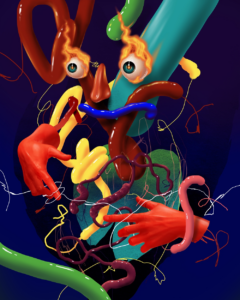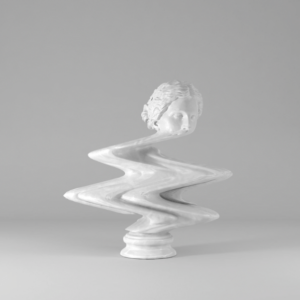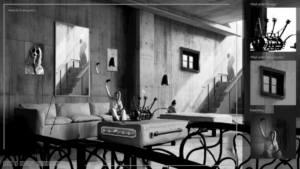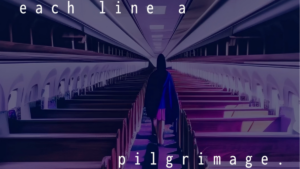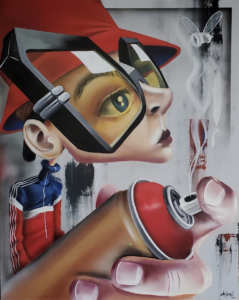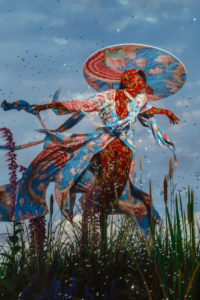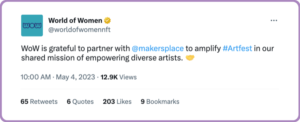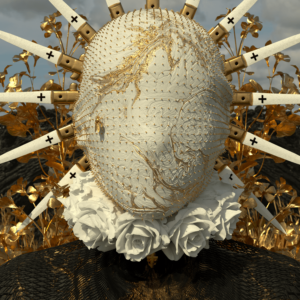In this fascinating and introspective interview with acclaimed artist Milana Juventa, we dive into the vibrant world of crypto art, artistic expression, and the creative process. We discuss their latest collection, Black Obsession, and how phenomenalism and reality intertwine to create a unique visual experience. From navigating the digital art landscape to cherishing traditional techniques, Milana Juventa shares their journey and the challenges of striking a balance between physical and digital work.
Brady Walker: Your website’s About section begins with: “I’m sinking deeper and deeper into the abyss, searching for some semblance of clarity.” Does making art provide that clarity, and if so, how?
Milana Juventa: By using metaphors like “abyss” and “clarity,” I aim to express the profound nature of my exploration into various themes and experiences. In my view, the act of creating art serves as a means to achieve this clarity.
Our brain has an incredible ability to find answers to our questions while we participate in creative activities, such as painting. By fully immersing ourselves in the creative process, we can access the unconscious mind and gain insights that might otherwise remain hidden. Personally, this is my preferred method of seeking answers to my questions.
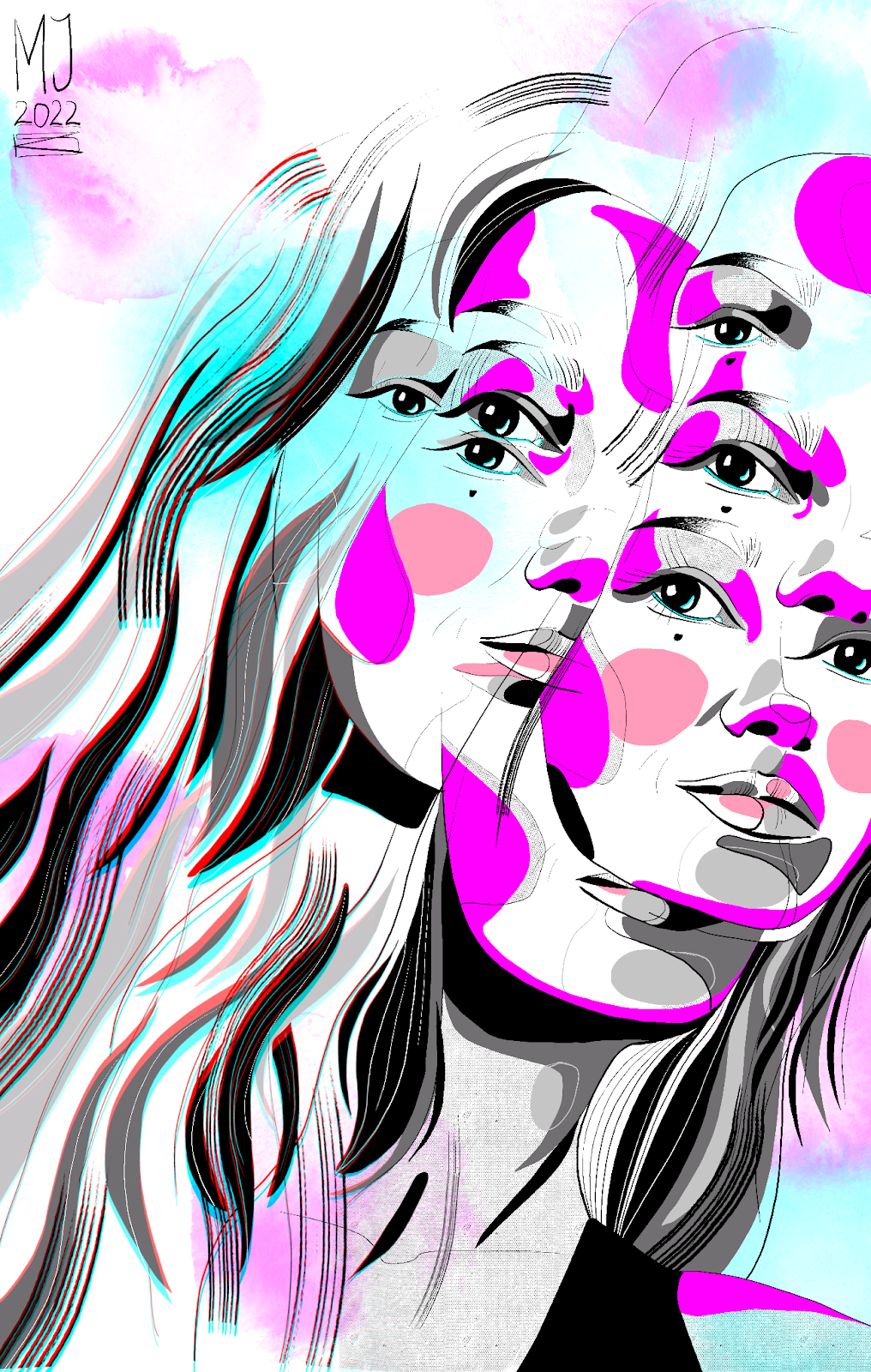
BW: Black Obsession is a series of expressive, colorful line drawings, which starkly contrast with your abstract work. Can you describe the genesis of this series?
MJ: As an artist, I don’t limit myself to a particular style or genre, even though I often identify as an abstract artist. With the Black Obsession series, I aimed to explore a different approach—one that was more visionary and surrealistic — while also drawing on my personal experiences and observations of the world around me. The series features expressive, colorful graphic drawings that diverge from my usual abstract works.
Creating this series was an exhilarating experience for me. I incorporated my own image and its variations into the work, which allowed me to delve deeply into the concepts and themes I was exploring. Specifically, the series reflects my thoughts on the idea that during difficult times, we often face multiple, superimposed realities. These realities can encompass the future and the past, alternate timelines, and other experiences that are simultaneously familiar and alien.
In essence, the Black Obsession series is a philosophical exploration of timeless themes, presented in a modern, vivid style. My hope is that viewers will find the works thought-provoking and inspiring, as they encourage us to question our assumptions and explore new perspectives.

BW: Can you elaborate on the phenomenalism you describe in relation to Black Obsession?
MJ: Phenomenalism is a philosophical theory that posits reality depends on an individual’s cognitive activity and is constructed by the individual. In other words, reality is subjective and varies from person to person based on their experiences and perceptions. This contrasts with realism, which asserts the objective existence of reality discovered through cognition.
In the context of Black Obsession, phenomenalism can be understood as a way of knowing reality as part of a personal multiverse. Each individual’s experience is different, and so is reality. This means that if a person is indoctrinated with an illusion, it can become their reality within their subjective space.
If illusions can influence individual realities, it raises questions about what one can experience by doing so. This idea is explored in the new Black Obsession collection, which delves into the concept of Black Possession and its connection to phenomenalism. Ultimately, the collection challenges us to question our understanding of reality and consider how our perceptions and experiences shape the world around us.

BW: Do you adhere to a similarly principle-driven approach in your abstract work as you do in Black Obsession?
MJ: In response to your question about my principled approach to creating abstract works compared to my approach in Black Obsession, I’d like to say that my fundamental approach to creating art remains consistent, regardless of the materials or techniques used. For me, the creation of art is a process that requires a thoughtful and intentional approach.
Regarding Black Obsession, I approached the creation of this series with the goal of exploring new facets and methods of perceiving reality. My approach to creating abstract works is similar, as I aim to create art that challenges and expands the viewer’s understanding of the world. I strive to create works that are thought-provoking and visually stimulating, encouraging the viewer to think beyond the surface level and delve deeper into the meaning behind the piece.
Whether working in abstraction or a more representational style, I approach the creation of art with the same level of care and thoughtfulness. Each piece is a unique journey that requires dedication and a willingness to explore new ideas and methods. Ultimately, my goal is to create works of art that inspire and engage the viewer, leaving a lasting impression that extends beyond the canvas.

BW: When is an abstraction more suitable for animation versus a still image?
MJ: Abstraction can be used effectively in both animation and still images. In animation, careful planning is required to ensure the abstract elements create a visually engaging and cohesive work. Still images allow for a focus on details and can be particularly effective in capturing the interplay of color, texture, and shape in abstract forms. Ultimately, the decision to use abstraction in either medium depends on the artist’s intentions and the subject matter.
BW: It’s possible uses a similar color palette to Black Obsession but is quite abstract with a touch of collage. Can you tell me how this piece came together?
MJ: The process of creating this piece began with a clear concept in mind, which guided the composition and color choices. As with much of my work, It’s possible is a reflection of my exploration of new ideas and techniques in the visual language of abstraction. The use of collage elements adds a layer of depth and texture to the piece, while the abstract forms and colors create a sense of movement and energy.
Throughout the creation of the piece, I experimented with different materials and techniques, allowing the work to evolve and take on a life of its own. This process of exploration and experimentation is a fundamental part of my approach to creating art, as it allows me to push the boundaries of my own creativity and discover new possibilities in the medium.
Overall, It’s possible is a work that speaks to the potential of the human spirit and the power of creativity to transform and inspire. The combination of abstract forms and collage elements creates a dynamic and visually engaging work that invites the viewer to explore and contemplate the message behind the piece.
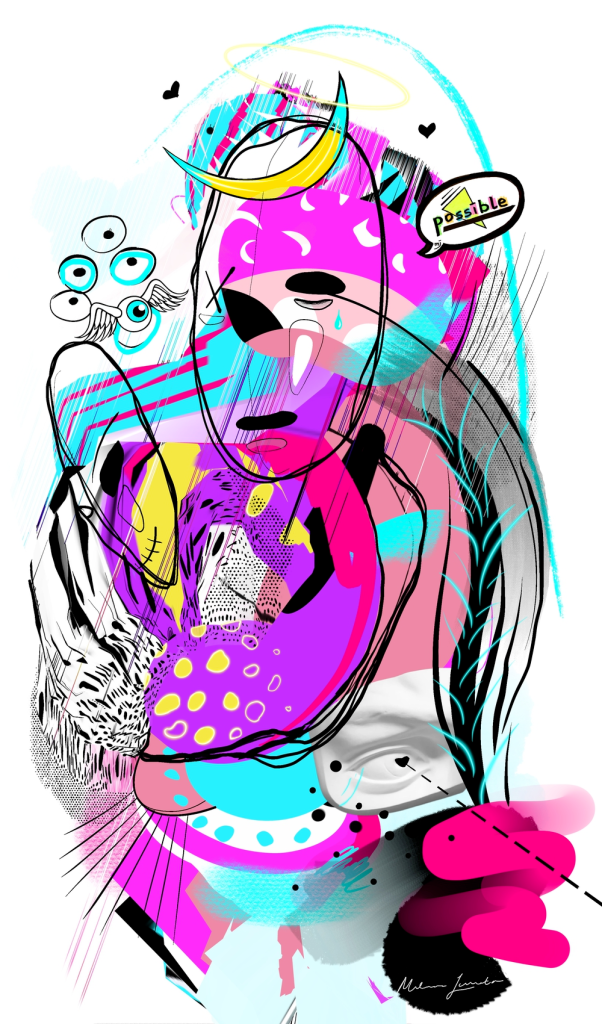
BW: The other work you have on MakersPlace is relatively simple compared to It’s possible (I’m tryin’, Hello GM, and Later). Are these part of a coherent series or just coincidentally similar?
MJ: The works I’m tryin’, Hello GM, and Later on MakersPlace are part of a coherent series, which began as quick sketches of concrete emotions in abstract form. These half-physical, half-digital paintings are little stories that share similarities in style and subject matter.
While these works may appear relatively simple compared to It’s possible, they serve an important role in the series. It’s possible was conceived as a genesis for the series and is much more complex and detailed than the others, setting the tone for the entire collection and acting as the face of the series.
Overall, each work in the series is unique and contributes to the exploration of abstract forms and the communication of emotional states. While they may differ in complexity and detail, they are all part of a cohesive body of work that reflects my vision and creative process.

BW: Can you describe the balance you strike between creating physical work and creating digital work? I’ve seen a few works on canvas on your Instagram, but it seems you’ve been primarily working in digital.
MJ: While it may appear that I mostly work digitally, I actually come from a traditional art background with a classical education, and I have been participating in physical painting exhibitions worldwide since 2008. My love for traditional materials means that my house is full of canvases.
However, in the past two years, I have focused more on digital art. It is faster and more convenient, especially when traveling, and it is also more popular in the current market. Despite this, I still value traditional art and may introduce new canvases in the future.
The balance between physical and digital work depends on the artist’s preference and circumstances. For me, the convenience of digital art has been beneficial during my travels, but I still cherish the traditional techniques that I learned and continue to explore both mediums.

BW: How does frustration manifest in your creative practice? What strategies do you use to get through or around it?
MJ: I believe that frustration is a trap of inflated expectations. While it is a common theme, I try not to project negative emotions directly into my creativity.
Instead, I focus on tuning in, creating, building and maintaining a community, and keeping my spirits up. Ultimately, the most important thing is to enjoy the creative process and the new experiences that come with it. We are all making history together, and that is something that I find very cool.
While frustration may manifest itself in different ways for different artists, I believe that maintaining a positive mindset and finding joy in the creative process can be an effective strategy for overcoming or circumventing it.
BW: Can you describe your involvement with crypto art? Are you an active collector? Are there any art communities you’re involved with?
MJ: My involvement in crypto art has been a priority for me since 2021. It’s a fast-paced and exciting journey that has become an important part of my life.
As an artist, I am also an active collector of NFTs. When selecting pieces to add to my collection, I follow my heart and choose works that resonate with me personally.
In terms of community involvement, I interact with various groups of artists and collectors within the crypto art world. We support each other in any way we can, from sharing tips and advice to promoting each other’s work.
My involvement in crypto art has been a rewarding experience, both as an artist and as a collector, and I look forward to continuing to participate in this growing community.

BW: Are there any crypto artists that have flown under the mainstream radar that you’d like to shine a light on?
MJ: There are definitely some crypto artists who deserve more recognition and exposure, and I would like to shed some light on them. I have many talented friends and colleagues in the crypto art world whose work is of high quality and deserves more attention.
Some of these artists include @klawmachineart, @Vojaart, @ssnow_wi, @ptiteAngele, @KateMacDonald, @Utkudedetas, @Andryusha_az… I believe that promoting and supporting talented artists in the crypto art world is important for the growth and development of the entire community. So, I encourage everyone to take a look at these artists and their work and help spread the word about their talents.
BW: What advice would you give your 20-year-old self about making a career out of art?
MJ: If I could give advice to my 20-year-old self regarding pursuing a career in the arts, I would say, “Don’t be afraid to try new things and explore different directions. Engage more with the creative community, work hard, and believe in yourself and your potential for success.”
For updates on all of our artist features, subscribe to our newsletter below.
- SEO Powered Content & PR Distribution. Get Amplified Today.
- PlatoAiStream. Web3 Data Intelligence. Knowledge Amplified. Access Here.
- Minting the Future w Adryenn Ashley. Access Here.
- Buy and Sell Shares in PRE-IPO Companies with PREIPO®. Access Here.
- Source: https://rare.makersplace.com/2023/04/15/interview-with-milana-juventa/?utm_source=rss&utm_medium=rss&utm_campaign=interview-with-milana-juventa
- :has
- :is
- :not
- $UP
- 1
- 2021
- 9
- a
- ability
- About
- ABSTRACT
- abstraction
- access
- acclaimed
- Achieve
- Act
- active
- activities
- activity
- actually
- add
- Adds
- adhere
- advice
- afraid
- aim
- aimed
- alien
- All
- allow
- Allowing
- allows
- also
- am
- an
- and
- animation
- answers
- any
- appear
- approach
- ARE
- around
- Art
- artist
- artistic
- Artists
- Arts
- AS
- At
- attention
- background
- Balance
- based
- BE
- become
- been
- began
- behind
- believe
- below
- beneficial
- between
- Beyond
- blockchain
- body
- both
- boundaries
- Brain
- Building
- but
- by
- came
- CAN
- canvas
- Capturing
- care
- Career
- careful
- challenges
- cherish
- choices
- Choose
- circumstances
- clarity
- clear
- cognitive
- COHERENT
- cohesive
- colleagues
- collection
- collector
- collectors
- color
- colorful
- combination
- come
- Common
- Communication
- Communities
- community
- compared
- complex
- complexity
- conceived
- concept
- concepts
- connection
- Consider
- consistent
- context
- continue
- continuing
- contrast
- contrasts
- convenience
- Convenient
- Cool
- could
- create
- creates
- Creating
- creation
- Creative
- creativity
- crypto
- Crypto Art
- Current
- decision
- dedication
- deeper
- definitely
- depends
- depth
- describe
- deserve
- deserves
- Despite
- detail
- detailed
- details
- Development
- differ
- different
- difficult
- digital
- Digital Art
- digitally
- directions
- directly
- discover
- discovered
- discuss
- Diverge
- do
- does
- doing
- Dont
- drawing
- Drawings
- during
- dynamic
- each
- Education
- Effective
- effectively
- either
- Elaborate
- elements
- emotions
- encourage
- encouraging
- energy
- engage
- engaging
- enjoy
- ensure
- Entire
- especially
- essence
- Even
- everyone
- evolve
- exciting
- Exhibitions
- exhilarating
- expands
- expectations
- experience
- Experiences
- exploration
- explore
- Explored
- Exploring
- Exposure
- express
- expressive
- Face
- facets
- familiar
- fascinating
- fast-paced
- faster
- Features
- few
- Find
- finding
- Focus
- focused
- follow
- For
- form
- forms
- Forward
- friends
- from
- full
- fully
- fundamental
- future
- Gain
- Genesis
- get
- Give
- goal
- Group’s
- Growing
- Growth
- Hard
- Have
- Heart
- help
- Hidden
- High
- history
- hope
- House
- How
- HTTPS
- human
- i
- idea
- ideas
- identify
- if
- Illusion
- image
- images
- important
- in
- In other
- include
- Incorporated
- incredible
- individual
- influence
- insights
- inspire
- inspiring
- Intentional
- intentions
- interact
- Interview
- into
- introduce
- involved
- involvement
- IT
- ITS
- itself
- journey
- just
- keeping
- Knowing
- landscape
- language
- lasting
- latest
- layer
- learned
- leaving
- Level
- Life
- light
- like
- LIMIT
- Line
- little
- Look
- love
- mailchimp
- Mainstream
- Making
- many
- Market
- materials
- Matter
- max-width
- May..
- meaning
- means
- medium
- message
- method
- methods
- might
- mind
- Mindset
- Modern
- more
- most
- mostly
- movement
- much
- multiple
- Multiverse
- Nature
- navigating
- negative
- New
- Newsletter
- NFTs
- objective
- of
- often
- on
- ONE
- or
- Other
- Others
- otherwise
- our
- out
- own
- painting
- paintings
- palette
- part
- participate
- participating
- particular
- particularly
- past
- person
- personal
- Personally
- perspectives
- physical
- piece
- pieces
- planning
- plato
- Plato AiStream
- Plato Data Intelligence
- PlatoAiCast
- PlatoData
- plugin
- Popular
- positive
- possibilities
- possible
- potential
- power
- practice
- preferred
- presented
- primarily
- priority
- process
- profound
- project
- promoting
- provide
- Push
- quality
- question
- Questions
- Quick
- radar
- raises
- realities
- Reality
- recognition
- reflection
- reflects
- regarding
- Regardless
- relation
- relatively
- remain
- remains
- required
- requires
- Resonate
- response
- rewarding
- Role
- same
- say
- searching
- Section
- seeking
- seems
- seen
- selecting
- SELF
- sense
- Series
- serve
- serves
- setting
- Shape
- Share
- Shares
- sharing
- shed
- shine
- similar
- similarities
- Similarly
- Simple
- simultaneously
- since
- So
- some
- something
- Space
- Speaks
- specifically
- spirit
- spread
- States
- Still
- Stories
- strategies
- Strategy
- strike
- strive
- style
- subject
- subscribe
- success
- such
- suitable
- support
- Supporting
- Surface
- Take
- talented
- talents
- techniques
- tell
- terms
- than
- that
- The
- The Future
- the world
- their
- Them
- theme
- There.
- These
- they
- thing
- things
- think
- this
- though?
- thought-provoking
- Through
- timeless
- timelines
- times
- tips
- to
- together
- TONE
- touch
- traditional
- Transform
- Traveling
- travels
- two
- Ultimately
- under
- understanding
- understood
- unique
- Updates
- us
- use
- used
- using
- value
- various
- Versus
- very
- vibrant
- View
- viewers
- vision
- visionary
- was
- Way..
- ways
- we
- Web3
- What
- when
- which
- while
- WHO
- will
- Willingness
- with
- within
- Word
- WordPress
- WordPress plugin
- words
- Work
- working
- works
- world
- worldwide
- would
- years
- you
- Your
- yourself

